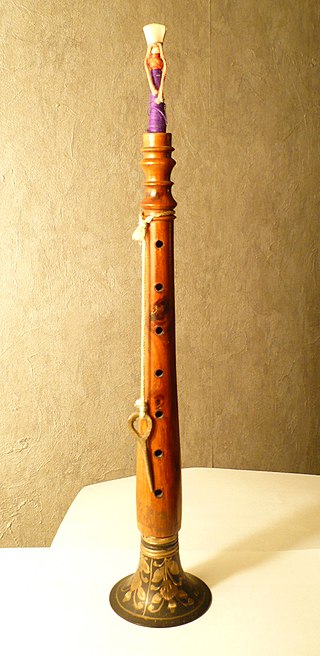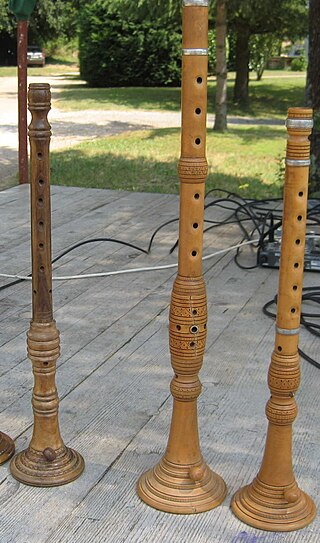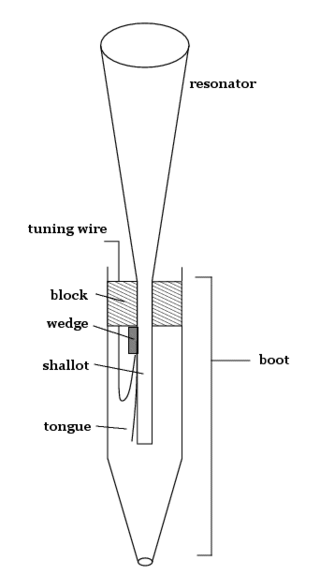
Max The oboe is a type of double reed woodwind instrument. Oboes are usually made of wood, but may also be made of synthetic materials, such as plastic, resin, or hybrid composites.

Woodwind instruments are a family of musical instruments within the greater category of wind instruments. Common examples include flute, clarinet, oboe, bassoon, and saxophone. There are two main types of woodwind instruments: flutes and reed instruments. The main distinction between these instruments and other wind instruments is the way in which they produce sound. All woodwinds produce sound by splitting the air blown into them on a sharp edge, such as a reed or a fipple. Despite the name, a woodwind may be made of any material, not just wood. Common examples include brass, silver, cane, as well as other metals such as gold and platinum. The saxophone, for example, though made of brass, is considered a woodwind because it requires a reed to produce sound. Occasionally, woodwinds are made of earthen materials, especially ocarinas.

A reed is a thin strip of material that vibrates to produce a sound on a musical instrument. Most woodwind instrument reeds are made from Arundo donax or synthetic material. Tuned reeds are made of metal or synthetics. Musical instruments are classified according to the type and number of reeds.

The shawm is a conical bore, double-reed woodwind instrument made in Europe from the 12th century to the present day. It achieved its peak of popularity during the medieval and Renaissance periods, after which it was gradually eclipsed by the oboe family of descendant instruments in classical music. It is likely to have come to Western Europe from the Eastern Mediterranean around the time of the Crusades. Double-reed instruments similar to the shawm were long present in Southern Europe and the East, for instance the ancient Greek, and later Byzantine, aulos, the Persian sorna, and the Armenian duduk.

The shehnai is a musical instrument, originating from the Indian subcontinent. It is made of wood, with a double reed at one end and a metal or wooden flared bell at the other end. Its sound is thought to create and maintain a sense of auspiciousness and sanctity and as a result, is of nine instruments found in the royal court. The shehnai is similar to South India's nadaswaram.

A piphat is a kind of ensemble in the classical music of Thailand, which features wind and percussion instruments. It is considered the primary form of ensemble for the interpretation of the most sacred and "high-class" compositions of the Thai classical repertoire, including the Buddhist invocation entitled sathukan as well as the suites called phleng rueang. It is also used to accompany traditional Thai theatrical and dance forms including khon, lakhon, and shadow puppet theater.
The sralai is a Cambodian wind instrument that uses a quadruple reed to produce sound. The instrument is used in the pinpeat orchestra, where it is the only wind instrument. The set of quadruple reeds are made of palm leaf. The bore of the instrument is not evenly bored, but "slightly conical." Its cousin, the Western oboe, has a double reed and a conical bore. The pinpeat instruments tune to the sralai's pitch, and the player must learn circular breathing to play continuously without stopping for breath. The sralai is very similar in construction and playing technique to the Thai pi.

A double reed is a type of reed used to produce sound in various wind instruments. In contrast with a single reed instrument, where the instrument is played by channeling air against one piece of cane which vibrates against the mouthpiece and creates a sound, a double reed features two pieces of cane vibrating against each other. This means, for instruments with the double reed fully exposed, that the air flow can be controlled by the embouchure from the top, bottom and sides of the reed. The term double reeds can also refer collectively to the class of instruments which use double reeds.

A single-reed instrument is a woodwind instrument that uses only one reed to produce sound. The very earliest single-reed instruments were documented in ancient Egypt, as well as the Middle East, Greece, and the Roman Empire. The earliest types of single-reed instruments used idioglottal reeds, where the vibrating reed is a tongue cut and shaped on the tube of cane. Much later, single-reed instruments started using heteroglottal reeds, where a reed is cut and separated from the tube of cane and attached to a mouthpiece of some sort. By contrast, in a double reed instrument, there is no mouthpiece; the two parts of the reed vibrate against one another. Reeds are traditionally made of cane and produce sound when air is blown across or through them. The type of instruments that use a single reed are clarinets and saxophone. The timbre of a single and double reed instrument is related to the harmonic series caused by the shape of the corpus. E.g. the clarinet is only including the odd harmonics due to air column modes canceling out the even harmonics. This may be compared to the timbre of a square wave.

During the reign of Queen Elizabeth I (1558–1603), English art and high culture reached a pinnacle known as the height of the English Renaissance. Elizabethan music experienced a shift in popularity from sacred to secular music and the rise of instrumental music. Professional musicians were employed by the Church of England, the nobility, and the rising middle-class.

The sopile is an ancient traditional woodwind instrument of Croatia, similar to the oboe or shawm. It is used in the regions of Kvarner, Kastav, Vinodol, Island Krk, and Istria. Sopile are always played in pairs so there are great and small or thin and fat sopila. Sopile are musical instruments offering very interesting possibilities with a unique piercing sound. This is replicated in more modern examples of Kvarner music through use of modified double reed clarinet or soprano Dulzaina. Sopile are, by "mih" and "šurle," and today are very popular in the folk traditions of Istria, Kvarner and Island Krk.

A reed pipe is an organ pipe that is sounded by a vibrating brass strip known as a reed. Air under pressure is directed towards the reed, which vibrates at a specific pitch. This is in contrast to flue pipes, which contain no moving parts and produce sound solely through the vibration of air molecules. Reed pipes are common components of pipe organs.

The bombard is a contemporary conical-bore double-reed instrument widely used to play traditional Breton music. The bombard is a woodwind instrument, and a member of the shawm family. Like most shawms, it has a broad and very powerful sound, vaguely resembling a trumpet. It is played as other shawms are played, with the double reed placed between the lips. The second octave is 'over-blown'; achieved via increased lip and air pressure or through the use of an octave key. It plays a diatonic scale of up to two octaves, although contemporary instruments frequently have added keywork permitting some degree of chromaticism. A bombard player is known as a talabarder after 'talabard', the older Breton name for the bombard.

The gyaling, literally "Chinese flute", is a traditional woodwind instrument used in Tibet. As its name indicates, it is the Chinese double reed Suona horn used mainly in Tibetan monasteries during puja and is associated with peaceful deities and the idea of devotion.

The gourd mouth organ is a free reed mouth organ played across East and Southeast Asia. It consists of a gourd wind chest with several bamboo or bronze pipes inserted on top of it, the numbers of pipes differing from region to region.
Traditional Thai musical instruments are the musical instruments used in the traditional and classical music of Thailand. They comprise a wide range of wind, string, and percussion instruments played by both the Thai majority as well as the nation's ethnic minorities.
Sarama is the music that accompanies the pre-fight ritual of Muay Thai matches.

Chirimía is a Spanish term for a type of woodwind instrument similar to an oboe. The chirimía is a member of the shawm family of double-reed instruments, introduced to North, Central and South America in the sixteenth and seventeenth centuries by the Spanish clergy.
Reed aerophones is one of the categories of musical instruments found in the Hornbostel-Sachs system of musical instrument classification. In order to produce sound with these Aerophones the player's breath is directed against a lamella or pair of lamellae which periodically interrupt the airflow and cause the air to be set in motion.
The ottu is a double reed wind instrument, used in Carnatic music of Southern India to provide a drone accompaniment to the similar nadaswaram oboe. Like the nadaswaram, the ottu is a large conical instrument, some two and a half feet long. Unlike the nadaswaram, the ottu has no fingerholes, being intended to produce one constant note while playing. It is provided with several small tuning holes which can be stopped with wax to modify its note. In some cases, a shruti box may be used in place of the ottu due to its steadier sound. The player holds the instrument in their left hand, sustaining the sound by inhaling through their nose, and with the right hand, beats on a drum strapped onto a belt.

















